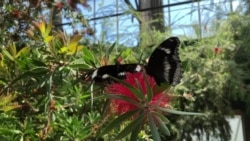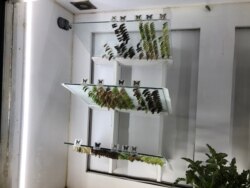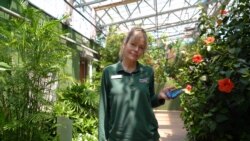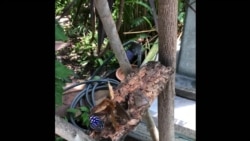Over 3,000 butterflies fly freely at the largest conservatory for the insects in the United States, Butterfly Wonderland.
The conservatory is located in Scottsdale, Arizona. More than 70 species of butterfly can be found there in 3,000 square meters of tropical paradise in the middle of the Sonoran Desert. Dayna Cooper is curatorial director.
“The landscape design here is highly specialized. It has to incorporate roosting areas for the butterflies. A lot of nectar for them to feed on, with absolutely no host plant material, and host plants are of course the plants that butterflies reproduce on. So, all the female butterflies out here do not have a host plant to lay eggs on, which is why we don't have caterpillars out in the Conservatory.”
Cooper says the butterflies are diverse in shape, size, and color and their life cycle is divided into four parts: egg, caterpillar, chrysalis and finally, adult butterfly.
“Each week, butterfly farmers send us a shipment of pupae (also called chrysalides (butterflies) or cocoons (moths).
Once we get them, we secure them to glass boards,” Cooper says. “Our Emergence area is where people can see and watch as butterflies emerge from their chrysalides, or moths emerge from their cocoons, dry their wings and then be released into the conservatory. Most people have never seen that happen. So it's very, very special.”
Cooper says the Blue Morpho is a popular butterfly at the conservatory, along with many others. The butterflies come from tropical Africa, Southeast Asia, Central and South America, as well as Florida.
Cooper has spent 20 years in the green industry, working in horticulture and natural resources management. Cooper has been a part of the conservatory since its beginning and has learned a lot of fun facts about butterflies that she shares with visitors.
“Butterflies have taste receptors on their feet. They don't have ears. They feed on nectar from flowers and fruit.
A butterfly finds food by using its large compound eyes—which are sensitive to light, movement, color, and patterns—as well as its antennae. The antennae may look like ‘feelers,’ but they have chemical receptors and are used primarily for smelling,” Cooper says.
Cooper says a new area of study about the butterfly is understanding the structure of the scales on its wings.
“Butterflies often have brightly colored wings with unique patterns made up of tiny scales. The scales are arranged kind of like roof tiles. Most butterflies don't have any pigment in those scales. So, without any scales at all, a butterfly's wings are transparent, totally clear. The color is structural. So, the way the light hits it and is reflected is what gives them their color,” Cooper says. “Those Blue Morpho butterflies that just flew past here are not really blue at all. We see blue because that's what's reflected by the scales on their wings.”
Cooper says butterflies are known for their beauty and watching them can inspire a sense of freedom and free spiritedness. Cooper says working at the conservatory is a pleasure.
“Each day I come into work is joy for me. I feel like one of the luckiest people in the world to have found this, which allows me to use everything I've learned pretty much in my life up until now. I'm surrounded by beauty and when people are in the conservatory, they're always happy and captivated by what they see.”














